
Trip Report: Crossing the Pacific in ANA’s Boeing 787-9 Business Class
On a recent trip to Asia, I had the opportunity to fly in Business Class on an All Nippon Airways…

Flair Airlines Boeing 737 MAX 8 in Halifax, Nova Scotia, Canada (Photo: AirlineGeeks | Vanni Gibertini)
Despite being the second largest country in the world with a very sparse population and vast distances among its main cities, air transport in Canada has not evolved as it has in most of the other G8 countries. The market is mainly controlled by two large carriers, Air Canada and WestJet, and fares are quite high if compared to those available to travelers in Europe and the U.S.
During the past few years, a small number of start-up carriers adopting the typical business models of ultra-low-cost carriers have commenced operations to try and break the oligopoly in Canada and bring its 38 million inhabitants the lower fare enjoyed by their counterparts South of the Border or across the Atlantic.
One of these carriers is Flair Airlines, a carrier officially launched in 2005 as a cargo airline but rebranded in 2019 to adhere to the low-cost airline model and recently expanded to include 22 aircraft (plus 8 due for deliveries by 2023) connecting 38 destinations in Canada, the United States and Mexico.
During the month of September, they launched a promotional sale offering thousands of seats at 49 Canadian dollars one-way ($36), so we took this opportunity to experience their product firsthand with a short trip from Montreal to Halifax.
During the booking process, it was easy to spot one of the reasons why low-cost carriers have always had a really hard time in Canada. To a net round-trip fare of C$0.99, these fees and taxes were added:
Therefore a 0.99 Canadian dollar net-fare would result in a 98.01 Canadian dollar all-in fare.
This fare only includes a personal item to carry onboard and store under the seat in front, however during both flights we were able to store our personal items in the overhead bins using the space available.
The maximum allowed size for the personal item is 6 x 13 x 17 inches, which is quite standard across the industry, and its weight is limited to 15.5 pounds. During our flights, this rule was not enforced very strictly, as most passengers had considerably bigger and heavier personal items.
Full size carry-ons (21.5 x 15.5 x 9 inches, or 55 x 40 x 23 cm) were offered for 33.34 Canadian dollars with checked bags costing 56.34 Canadian dollars for the first two items (49 Canadian dollars + taxes) and 90.38 Canadian dollars for the subsequent items (79 Canadian dollars + taxes).

Prices for extra items on Flair Airlines (Photo: AirlineGeeks | Vanni Gibertini)
During the booking procedure, some bundles are offered to reduce the price of extra items, but they are capacity controlled because on some flights the price of the bundle is simply the sum of the individual items.

Flair Airlines – Baggage Bundles (Photo: AirlineGeeks | Vanni Gibertini)
The outbound leg was flight F8 827 from Montreal YUL to Halifax YHZ on Wednesday, October 19 at 12:20 p.m., and it was operated by one of the three Boeing 737-800 aircraft still operating for the airline. All the other 19 aircraft are new generation Boeing 737 MAX 8 aircraft. Flight time was approximately 1 hour 35 minutes.
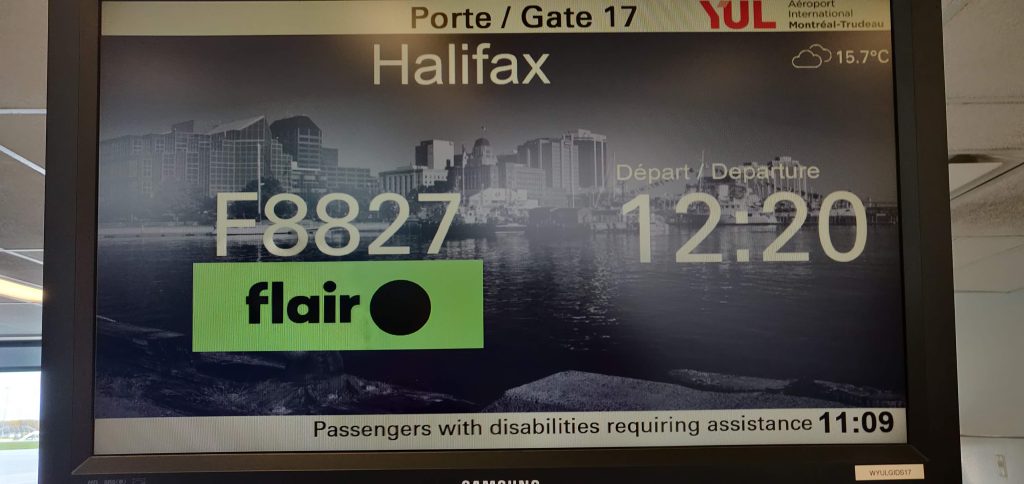
Flair Airlines – gate departure screen at Montreal Trudeau Airport (Photo: AirlineGeeks | Vanni Gibertini)
The airline strongly encourages passengers to check in online via the website or the smartphone app, as having the boarding pass printed at the airport triggers a 25 Canadian dollars. On the outbound sector, online check-in was quite smooth, while on the return sector it took several hours and more than a dozen attempts to complete the procedure. It seems a recurring issue with the carrier, since when calling their customer service number, a recorded voice says that in case of problems with online check-in the charge will be waived.

Flair Airlines – Check-in area at Montreal Trudeau Airport (Photo: AirlineGeeks | Vanni Gibertini)
Passengers with bags to check-in can avail of a quite large check-in area in the main terminal, considering there is rarely more than one flight open for check-in at the same time (check-in opens 3 hours before departure).
Boarding took place from gate 17 in one of the remote islands: only the Flair Airlines flight was departing from there at that moment and it was organized in three groups. The seats are fairly dated, after all this is one of the oldest aircraft in the fleet, and the thicker old-fashion seats make the 30-31 inch seat pitch particularly uncomfortable for tall passengers.

Seat pitch on Flair Airlines Boeing 737-800 (Photo: AirlineGeeks | Vanni Gibertini)
In the back-seat pockets, there are two laminated sheets: one for the safety instructions and the other for purchasing refreshments. There is no trolley service: all refreshments are purchased on-demand and payment is exclusively by credit card: no cash is used onboard.
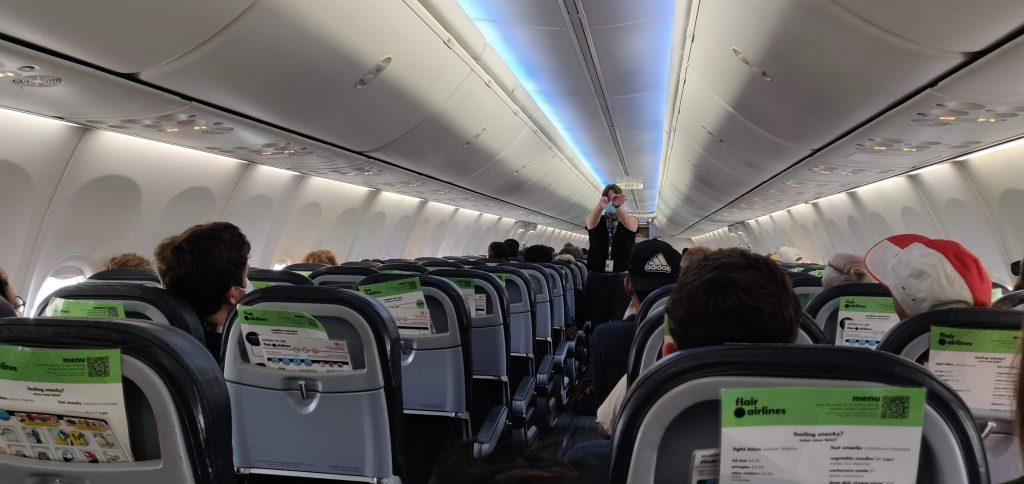
Flair Airlines interior of Boeing 737-800 (Photo: AirlineGeeks | Vanni Gibertini)
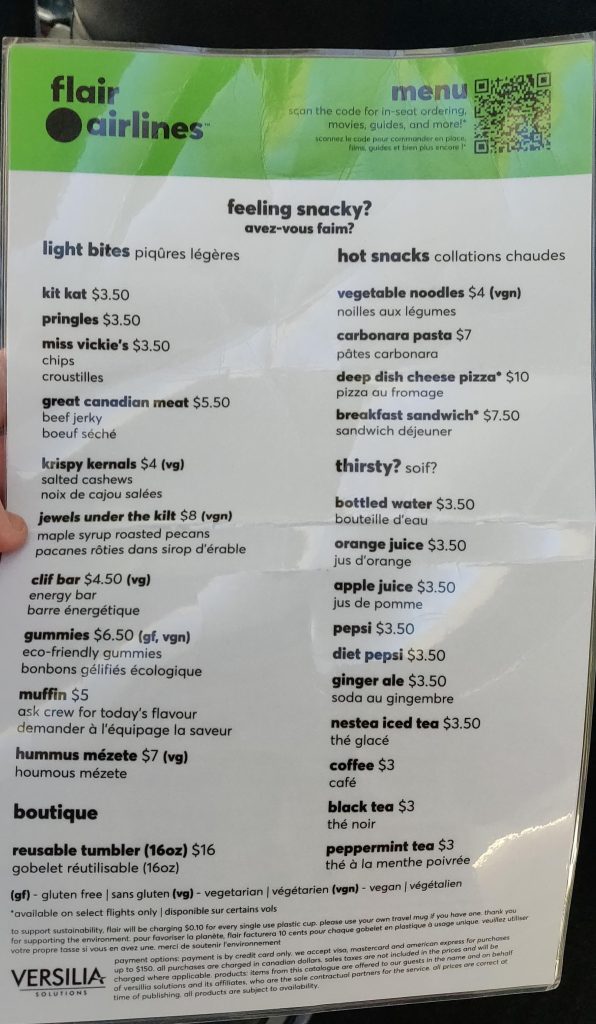
Flair Airlines onboard menu (Photo: AirlineGeeks | Vanni Gibertini)
Departure was delayed by approximately 20 minutes since the headcount had to be repeated several times: some passengers were repeatedly called through the public announcement system, as they had probably checked a bag but did not show up at the gate.
Unlike what happens with U.S. and especially European low-cost carriers, there doesn’t seem to be any emphasis on shortening the turnaround times. This may be explained partly by a difference in culture and partly by the fact that Flair’s network structure includes a large number of longer routes which limits the possibility of cramming extra sectors into the day if turnaround times are optimized.
The return leg was flight F8 828, scheduled to depart Halifax on Friday, October 21 at 11:20 a.m. The flight was operated with a Boeing 737 MAX 8 aircraft with a newer configuration, and three fewer seats (186 versus 189). The thinner seats made the perception of the seat pitch much more comfortable.
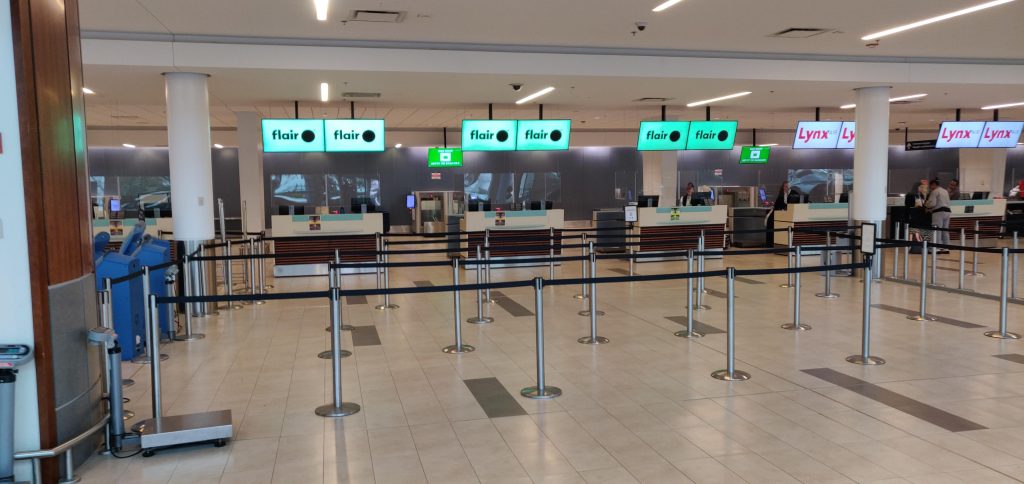
Flair Airlines – Check-in area at Halifax Stanfield Airport (Photo: AirlineGeeks | Vanni Gibertini)
The overhead lockers are the wider Space Bins, which are supposed to store up to 50% more carry-ons provided they are arranged lying on the smaller side. This would require passengers to know how to put their suitcases in the bins, to read the instructions or to be assisted by cabin crew in performing the operation correctly, none of which actually happened on our flight.
The Boeing 737 MAX 8 is supposed to be equipped with WiFi and free inflight entertainment to be streamed to the passengers’ individual screens, but on our flight, the system was not operative.
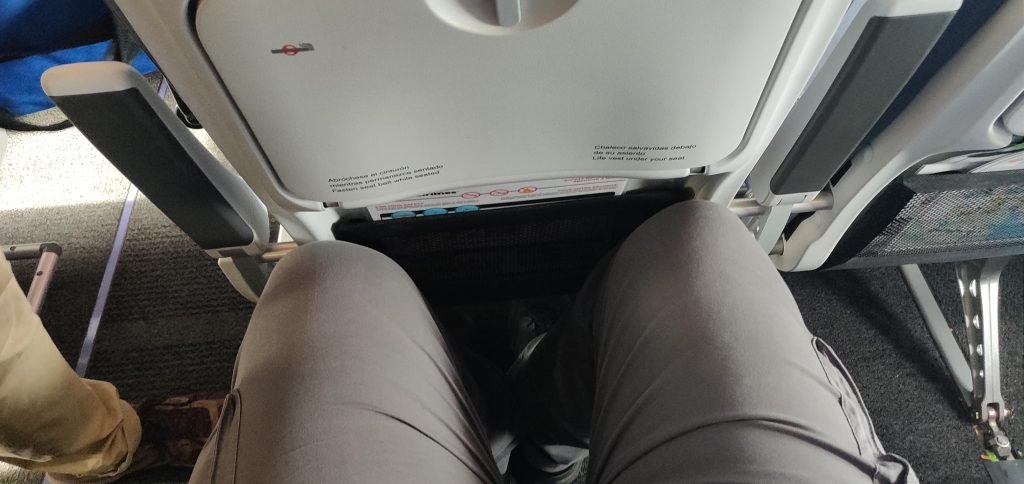
Seat pitch on Flair Airlines Boeing 737 MAX 8 (Photo: AirlineGeeks | Vanni Gibertini)
The flight was at first delayed by approximately 30 minutes by the late arrival of the aircraft, but actual departure took place almost an hour late due to another quite slow boarding procedure. Flight time was a quick 1 hour 15 minutes.
On both flights announcements and the safety briefing were made in both Canada’s official languages. The order of the two languages appeared quite casual, while on other carriers it is usually English first and then French, except for when the aircraft is departing or arriving in Quebec when languages are switched and French is first due to local Quebec language laws.
The general impression is of a very young airline that still needs to iron out and standardize its procedures: for example, there appear to be strict checks for fastened seat belts whenever the signal is on, but before take-off and landing heavy objects like laptops are tolerated in the seat-back pockets and, while a flight attendant insisted for a personal item to be completely under the seat in front of the passenger, it was completely overlooked that jacket and purse of the same passenger were casually thrown on an empty seat next to them, when they should have been securely stored for take-off.
While Flair’s effort to bring lower fares to Canada needs to be appreciated and supported, their baggage policy appears to be quite punishing: once we include all the charges for the items that would be included in a basic ticket in a full-service carrier, prices tend to become quite similar. For example, unless a specific seat is purchased during the booking or even at check-in, it is impossible to ensure that all the members of the same party will sit together. If no seat is being paid for, the system automatically assigns a seat without the possibility of choosing it or changing it.
Incumbent carriers can avail of large amounts of data to respond to lower fares launched by ultra-low-cost carriers: since they usually have a much higher number of frequencies on routes where they are under attack by budget competitors, they can just reduce the price of one of their flights of the day, usually the worst performing, in order to remain competitive without diluting too much of their revenue. This makes it difficult for new entrants like Flair but also like Jetlines and Lynx Air to compete effectively against Air Canada and WestJet.
Canada is also a difficult market to put in place the usual strategies adopted by low-cost carriers: airports tend to be quite expensive, and there are very few secondary airports that could provide better deals, so low-cost airlines are stuck paying the same high prices charged to their full-service counterparts. Flair Airlines has started services to some of the secondary airports serving popular destinations in the United States, such as Orlando Sanford (SFB), Phoenix-Mesa (AZA) and Los Angeles Burbank (BUR), on top of obtaining incentives from underserved communities in Canada like Kitchener-Waterloo, Ontario, Lethbridge, Alberta and Prince George, British Columbia.
Vanni fell in love with commercial aviation during his undergraduate studies in Statistics at the University of Bologna, when he prepared his thesis on the effects of deregulation on the U.S. and European aviation markets. Then he pursued his passion further by obtaining a Master’s Degree in Air Transport Management at Cranfield University in the U.K. followed by holding several management positions at various start-up carriers in Europe (Jet2, SkyEurope, Silverjet). After moving to Canada, he was Business Development Manager for IATA for nine years before turning to his other passion: sports writing.
Receive a daily dose of the airline industry's top stories along with market insights right in your inbox.

On a recent trip to Asia, I had the opportunity to fly in Business Class on an All Nippon Airways…

Hawthorne, Calif.-based Advanced Air has been slowly but modestly increasing air service in the southwestern part of the country adding…

Icelandair serves many destinations in North America, and even more in Europe. The airline offers an extensive stopover program that…



